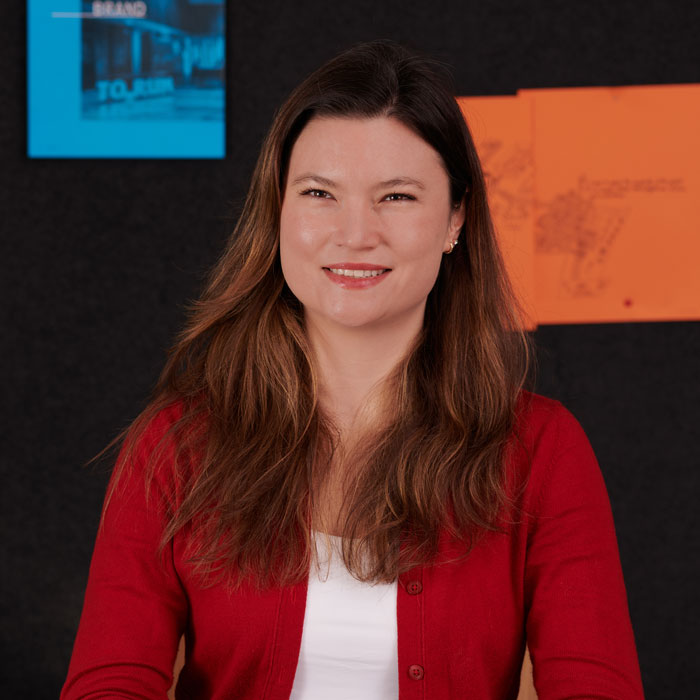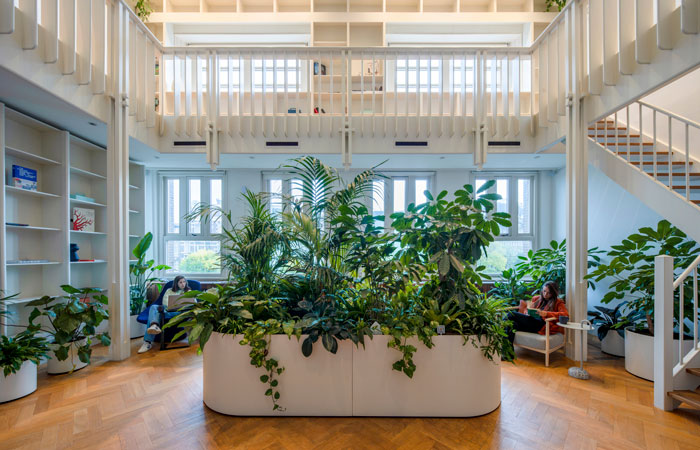Sustainable Innovation Interview Series: Sam Allen, M Moser Associates
Understandably, sustainability is an important topic of conversation between Commercial Interior Designers and Suppliers. This series of interviews aims to share knowledge of new materials but goes on to challenge how circularity can succeed in the commercial sector and what that production model may look like. We also focus on action by asking our interviewees to share examples of how they’ve delivered sustainably innovative projects in order for the sector as a whole to learn and grow.
We sat down with Sam Allen to learn from her expertise in delivering global interior projects.
Enjoy the full Sustainable Innovation Interview Series here

Please could you introduce yourself and your role?
I’m an Associate Director for global sustainability and wellness initiatives and projects at M Moser. My role involves carbon evaluation, sustainability certifications, helping clients meet their ESG goals in their real estate footprint, material vetting, air quality management, and more.
What innovation have you found in materials suitable for commercial interiors?
Some key innovations have been in finding new material building blocks – of course, recycled content is always good to see. Still, some companies are seeking out unconventional “raw” materials such as used fishing nets (which make up around 60% of plastic in the ocean) to make mesh backs for task chairs or scraps and used clothes from the fashion and textile industry to make a chipboard equivalent (which can be indefinitely recycled). One area that needs more innovation is the end-of-life planning for materials – plenty of companies, particularly carpet companies, have take-back programs. Still, the times this actually happens are few and far between. We need more robust practices that promote take-back and recycling from every stakeholder in a project.

Miro, Amsterdam design by M Moser Associates
Can circularity truly be integrated within a commercial interior project?
Circularity and the built environment have not traditionally gone hand-in-hand – most of the products we see in the commercial interiors industry are furnishings, which are considered consumer products, like trainers or clothing. However, we are seeing increased interest in re-using and re-purposing many workplace materials. Most task chairs have lifespans of 15+ years, but a typical fit-out lasts only 7, so companies are re-using existing stock to save on money and embodied carbon. Sometimes the re-purposing is a bit more creative, for example, changing existing tables that no longer fit a new space into a whiteboard or temporary partitions.
One common building material that is evolving and becoming more circular is lighting fixtures. There are new, innovative companies that incorporate service models for take-back and repair programs. These programs help reduce the waste generated by discarded lighting products. Lighting fixtures typically comprise aluminium, steel, and glass, three fully recyclable materials. These materials can be broken down and reformed without losing structural integrity (indefinitely).
For circularity to be fully integrated into a project, we need to start by thoughtfully selecting fewer new materials from the outset and using more solid materials (that are easier to break out into components for re-use or re-purposing), like wood, which can have a negative carbon value (since trees capture carbon). As such, we have to really study and understand the properties and benefits each type of material offers. At M Moser, we specify sustainable and innovative materials in our offices, referred to as our Living Labs. It helps us learn and live with the products ourselves first. Then the knowledge we gain allows us to curate the materiality based on a specific project and its goals. For instance, each variety of stone has a thermal mass, which is the ability of a material to capture and store heat. Marble, specifically, is an excellent example of a material that has not always been thought of as being sustainable but can be in the right circumstances – its high thermal mass allows for heat absorption and humidity regulation in hot climates (reducing the need for mechanical cooling) and is one of the most durable materials in the world (think of the Colosseum and the Great Pyramids of Giza). In addition to its thermal properties, stone falls in the biophilia category as it has minor modifications from its natural state, which adds to the overall connection with nature in space. Working to minimise the quantity of materials while promoting the use of quality, sustainable materials is a step toward achieving a greener future.
How have you addressed innovation within the installation, or demolition stage, of your projects?
Our first focus is to minimise waste by re-using and re-purposing materials in new and innovative ways. Our Senior Sustainability Specialist, Steve Wheeler, works closely with our project managers to track carbon activities across projects and promote re-using existing elements and materials to avoid being sent to landfills or turning waste into energy. He has also helped to implement the use of new technologies that support destruction and associated carbon tracking. For example, we use a technology that incorporates sophisticated OCR (Optical Character Recognition) to read and scan waste tickets, categorise waste into streams, and quickly perform calculations. The technology allows for accurate quantification of waste streams and end-of-life carbon estimations (especially useful for Scope 3 emissions reporting). Although this technology can be expensive, there are ongoing case studies to test its effectiveness and determine implementing it in other projects. By testing and implementing these innovative technologies, businesses can contribute to reducing waste and promoting sustainable practices in their projects.
What do you need from suppliers in order to deliver sustainable projects which achieve high levels of accreditation?
Transparency of materials is an essential consideration for companies looking to promote sustainable practices. One aspect of this is implementing a sustainable procurement policy that allows us to understand how the supplier sources each product component. This policy helps provide information to our sustainability team to ensure the product and all activities associated with the product are conducted sustainably, ethically, and fairly. We also look at third-party verified product certifications, such as FSC (Forest Stewardship Council) certified woods and EU Ecolabel or Greenguard GOLD for VOC levels. These certification schemes consider different elements under the sustainability and wellness umbrella, which allows our team to verify that the product can meet the stringent criteria that the building certification programs require (e.g., BREEAM and LEED). However, the cost of product certifications can be prohibitive for smaller companies, so it’s essential also to understand testing results and manufacturing methods so that products can still demonstrate meeting the VOC criteria (or other transparency measures). For smaller suppliers, providing a test result rather than a certification may be more accessible. If companies don’t have access to big testing companies, they could collaborate with local universities that do research into materials (and encourage younger generations to conduct research). Testing the VOC levels and providing the results for all products, including flooring and wall finishes, is very important to maintain healthy air quality and can satisfy the air quality requirements that appear in the larger certification schemes. For older products, it’s possible to write off VOC requirements, as these volatile chemicals would have already off-gassed and no longer pose a threat (more reason to re-use!). Chain of custody is also crucial, and it’s important to trace where raw materials come from and how they’ve been handled, which you can get by using FSC-certified wood, for example.
What is the next step in our sustainable conversation, and who is it between?
It is working with organisations such as the BCO and government bodies to promote sustainable practices in the workplace. One area of concern is the average recommended space per person in offices, which has recently increased to 10 square metres. Regarding building certification, the BREEAM Very Good standard is no longer good enough, and industry players need to consider Excellent or, ideally, other certifications that address Net Zero. Additionally, there is currently no generally accepted baseline carbon footprint for a fit-out, which can lead to measurement inconsistencies. At present, we estimate the average carbon footprint for a fit-out is around 100 kgCO2e per square metre, as items in a fit-out can add up quickly. While the industry needs an official source for sustainable measurements, it will have to come from within the industry first. By collaborating and committing to sustainable practices, the industry can take the next step towards promoting sustainability in the workplace.




